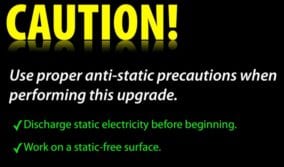
Related article: What You Need to Set Up Your Own DIY Upgrade Lab
So often we are asked in reference to our OWC Instructional Series of Videos, “How exactly am I supposed to ‘Use proper anti-static precautions when performing this upgrade’?” The real answer is…it depends. There are actually several different ways, depending on your situation, that you can help to control static electricity in order to avoid damaging the electronically delicate components found inside your computer.
What is a Static Free Surface?
According to Wikipedia: Static electricity refers to the buildup of electric charge on the surface of objects. The static charges remain on an object until they either bleed off to ground or are quickly neutralized by a discharge. And it’s that discharge that can ‘zap’ or ‘fry’ your computer components, rendering them inoperable.
To give you an idea of how little static electricity needs to be generated to cause harm to your computer components, it takes as little as 5 to 10 volts to cause damage inside your computer. In order for you to even feel the presence of static electricity, the level needs to be above 1,500 volts. You can accumulate an average of 10,000 to 12,000 volts just walking across carpeting. Rubbing a balloon on dry fur (or hair) generates about 20,000 volts.
Did you know the average person can carry up to 25,000 volts of static energy at any given time? So discharging any built-up static energy before you begin is important!
How Are We to Be Safe When Working on Our Computers?

Keep in mind the following suggestions are for working inside the computer itself – these rules change when working on a monitor where grounding yourself can prove to be hazardous.
First off…
Prepare your workstation. You want to work on a clean, dry, static-free surface. In most home situations, a cleared-off kitchen table provides the best place to work. And, depending on the likelihood of generating more static electricity in the area, no more prep to the workspace should be necessary. However, there are always additional factors to consider: Keep in mind the following suggestions are for working inside the computer itself – these rules change when working on a monitor where grounding yourself can prove to be hazardous.
- If you have a cat (or dog, or ferret), keep them shut out of the area you’re working in. Cats are living static electricity generators and combined with their curiosity to see everything you’re working on, make for a bad situation when working inside your computer.
- Be mindful of the humidity. A humidity level between 35 and 50% is ideal. A cold winter day tends to have humidity levels too low and becomes a great environment for accumulating those pesky electrons. A hot summer day with the A/C running can also have the same effect. Now, too humid of a room isn’t good for electronics in general either; so use a humidifier or dehumidifier as necessary.
- As mentioned, keep the workspace cleared off. Plastic garbage cans, telephones, cellophane, even paper being moved on your workspace can generate static.
- If your workspace is prone to static electricity buildup or located in a carpeted area of the house, or on a rug, or if you just want to be extra careful; you can always clean the area first with an anti-static spray. You can pick up anti-static spray in most mega-marts, hardware stores, electronics stores, and many places you buy your normal cleaning supplies from. Alternatively, you can make your own by mixing liquid fabric softener with water. Just spray on non-porous surfaces and wipe clean with a clean, dry cloth. For porous surfaces such as carpeting, rugs, drapes, sofas, chairs, etc. simply spray lightly and let air dry.
- Speaking of fabric softener, try carrying an anti-static dryer sheet in your pocket, and rubbing it once in a while. This works to dissipate static for people as well as laundry.
How to Discharge Static

The other component to safe installation is to discharge any static electricity from yourself before starting. Just like when we were kids and dragged our feet on the carpeting trying to gather up as much static electricity we could in order to ‘shock’ our siblings or friends, we need to discharge that shock before we start working on our computers. Many times, you won’t even feel the shock happen – as mentioned earlier, 5-10 volts can cause damage, but it takes 1,500 volts for humans to even perceive the effects of static. Once the static is discharged, we then just need to not accumulate anymore while we’re working inside the machine.
- For most of us, touching a grounded object before beginning will be just fine. Then proceed with your install in your anti-static environment.
- You can ground yourself with most computer models by touching the metal chassis inside the case. That is, provided the machine is turned off, plugged into a properly grounded outlet, and has a metal chassis. If the machine isn’t grounded, you’re actually causing the damaging discharge we’re trying to avoid on purpose.
- For machines with a ‘rocker switch’ for turning the power on/off, you can leave the machine plugged in while you work in order to actively discharge electricity. This method is NOT advisable if you have a touch-sensitive power switch such as an iMac. You never want to install or remove components while the machine may be running or you can risk looking like the OWC Globeman above. For touch-sensitive models, ground yourself and the machine, then unplug the unit.
- Alternately, you can find power cords with only the ground pin at many electronics stores that you can use to ground the machine without the risk of turning it on while working inside. Or, you can make one if you have a spare power cord (don’t use the one you run the machine with). Simply clip or grind the two flat prongs leaving only the ground pin. Plug that cable in instead when working on the machine and you can actively ground without possibly turning the machine on.
- For greater safety, you can actively discharge any static buildup while working through the use of an anti-static strap. Basically, this device tethers you to the machine, thus creating a symbiotic relationship between you and the machine where any charge is shared between you and no discharge between the two of you can occur. No discharge = no damage.
- If you perform a lot of upgrades (as we do here at OWC), the investment of an anti-static mat for a static-free surface is advisable. You’ll see on our videos that the installations are performed on a light blue surface which is one of our anti-static mats. Follow all instructions on the mat for installation as many need to be grounded in order to be operational. Otherwise, they collect static rather than dissipate it.
More Tips
There are a few other tips for static electricity control I’d like to share with you. Many of these are more common sense than actual tips, but do bear mentioning:
- Turn your computer OFF before discharging static electricity. With a current of electricity running through the machine, the likelihood of damage to the computer (or yourself) greatly increases. Remember, it’s not the sheer voltage that causes electrocution; it’s current that does.
- Keep your RAM, processors, expansion cards, etc. in the anti-static bags that they came in until you’re ready to install the component. The bags are designed to specifically protect the component from accumulating any static, so let it do its job.
- When you do remove or install components, always handle them on the edges away from the connectors or pins where electricity is normally transmitted to the device.
- Always allow components to reach room temperature before installing. Static electricity builds up faster when cold and dry.
With a little knowledge and a little common sense, you can upgrade your computer safely and easily!








Can connecting a battery direct to positive and negative terminal (without the center terminals)cause the buid up of electrostatic in a pc when connected to charger and cause it not to open up?
Which surface is preferable for discharging my laptop’s static build up?
Thank for the detailed explanation. I just have one question.? What if the case has a static buildup. Is there any way i can naturalize the buildup before installing.
Thank u kindly
There shouldn’t be any static buildup on the case as long as the computer is plugged in, as this acts as a ground. If you are still concerned, touch the case while the computer is still plugged in, and you are standing on a solid, uncarpeted surface. After this, unplugging and handling components should not be a problem.
Thank you for the information. I just wanted to know if you are an Information Technology Graduate. I need to interview someone who is an IT graduate or is working as an IT or related to that . Please let me know thank you very much. :)
My iPhone has been running erratically uncontrollable when turned on although sometimes it behaves normally. If indeed electric static charge is the cause of it, how can I de-static it without dismantling the phone? Thanks for responding.
Great info, thank you. One question. It seems in the grounding yourself section, you suggest leaving the computer plugged in. Isn’t it safer to unplug completely, and ground youself to the computer case? Thanks!
Leave it plugged into a grounded 3-prong outlet, discharge static from yourself by touching the metal case or inner shielding or other metal parts connected to the case, then you can safely unplug it if you want as long as you don’t move around much. If you’re going to be walking around, it’s better to leave it plugged in.
Really helpful information!
Thanks!
How do you get rid of a static charge if you suspect it has killed your computer
Thanks, interesting, but just want to change my computer battery, not do any internal upgrades and you don’t speak to that.
I have a black MacBook 2007 so don’t know how to ground that. May try to take it to a repair person rather than risk damage.
Your MacBook has an externally user-accessible removable battery covered in plastic. I think you’ll be fine. haha
When using a power cable modified with just a ground pin, would you flip the power switch to the “on” position?
Seems like this would be necessary to completely ground the unit.
Great post with great content,
I really like that you are sharing such post here.
Thanks for reading! You can also sign up for the Rocket Yard Weekly newsletter and have the best content of each week delivered to your inbox.
^ comments like these are 99% of the time spammers getting a comment mod-approved so they can come back and spam you later. FYI
I cam across this really good youtube video on electrostatic discharge:
Hi There,
Thank you for your valuable site.
I was looking for what you recommend for changing memory on Mid 2010 iMac, “SOFT ANTI-STATIC surface”.
All I want is something cheap that is in the normal home – I may not need to use it ever again.
I got the anti static bit, but what about the SOFT bit?
I mean, a wooden blanket?
A feather pillo?
A polyester pillow?
A cotton sheet?
A rubber mat?
A silicone rubber mat?
Some of these may have more static than others???
Many thanks again for your valuable site.
I hope I can get the RAM out without breaking the tabs; my iMac is 5 years old and he chips are very solidly fixed in their slots.. With all my thumb strength I have not been able to budge them. Next the dreaded pliers and a leverage block!
On a high-tech computer? Surely this is not a jammed mine-shaft pulley wheel?!!!!!
I look forward to your helpful response.
Kind regards,
Meryn Broomhead
Hi, Meryn. Any static-free surface that will not scratch the iMac’s screen would work. We offer an instructional video to guide you through the RAM removal process, which can be found here. For further assistance, feel free to contact our customer support team.
Thanks Jarrod.
I have read your blog & watched the video and understand what to do except what to use as a soft material that is most likely to be static free. But maybe I am trying to be too smart and should just use a cotton towel on the kitchen table and take all the other precautions?
Using a smooth, clean wooden or glass table would work for the static free surface and avoid doing the upgrade on a carpeted floor if possible.
Many thanks All.
Job done with earth-only (3-pin UK 240V plug minus live & neutral pins), damp-with-fabric-softener cotton towel on granite kitchen worktop, copper wire wrist-strap connected to iMac metal case, bare-foot on wooden block floor and wearing only cotton clothes & no jumper. WOW! What a specification!
Now iMac up & running with 12GB :-))
Only remaining question is:”Does it matter whether 2 X 4GB RAM cards are in front pair or back pair of slots?”
to do
Useful info
Thx
What about wearing rubber/latex gloves?
isn’t really useful if anything it actually makes working with the pieces of your computer more difficult. static electricity is better to be handled by grounding it
I was looking at some anti static wrist bands, and I noticed that they had metal clips which you attached to metal parts on the computer, I was wondering if the metal clip will scratch or damage the case of my 13″ MacBook Pro.
yes it can if you are not careful with it but otherwise you should be fine it isn’t really ment to move around or scratch anything
Clip it to part of the metal shielding or other protrusion on the inner part of the case, with the power off but plugged into a grounded (three prong) outlet.
The ESD mat I have is made of a foam rubber/vinyl type substance – I’m sorry, I don’t have the exact specs on the material. (I’m sure that foam density and chemical composition play big factors in the effectiveness of the mat.) But the key to the mat I have in particular is the cord which comes from the mat itself and in screwed into the grounded housing of an electrical outlet.
With this system, the foam rubber/vinyl acts as a static collector and the grounding cable then grounds that static.
We have several here at OWC made to custom sizes and you are correct, that material does get quite pricey. For those of us that work inside computers day in and day out, it does make sense to invest the money in the ESD system – However for the occasional upgrade, the other suggestions in the article are much more cost efficient and just as effective.
Thanks. I do my own amateur upgrading and needed this common sense summary very much. In particular, I am wondering what is the name of the substance/s that professionally manufactured ASD mats are made of? They are very expensive, and they appear to be made of a flexible plastic material that ought to be commonly available.
If you’re working on carpet, do everything this article says AND take off your shoes. Your socks will probably be a little damp from perspiration and they will discharge any remaining static electricity from your body into your carpet. Then, keep your feet on the floor and don’t rub them back and forth on the carpet.